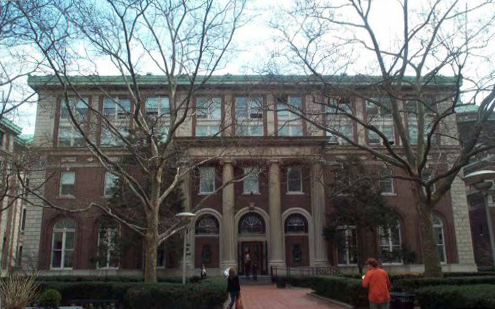6.4.2. Chemical Corn Exchange Bank, 1954-1957
- Extent:
- Scope and content:
-
Consists of correspondence, transmittal forms, agreements, construction orders, and financial records for the work performed on the area for the Chemical Corn Exchange Bank (later Barclays Bank of New York). Within these documents, there are accounts of all aspects of the construction incorporating structural steel, electrical work, masonry, cement, plumbing, vault installation, concrete work, roofing, metal lathing, heating, ventilating and air conditioning systems, flooring, terrazzo, carpentry, doors, painting, glass, plaster, tile, ornamental metal work, and fixtures. The correspondence with the tenant communicates their structural needs based on the lease clauses, anticipated costs, and vault requirements. Other correspondence about the building of this commercial space discusses approvals of architectural drawings, revisions to the proposed design, budget estimates, contingency plans, materials used, subcontractor matters, field inspections of work completed, instructions for the resolution of problems, and payment of incurred expenses. Interoffice memorandums represent the Urises' involvement with this facet of the construction project, including architectural plans, purchase orders, progress reports, punch lists of unfinished items, and payment of subcontractors. The drawing transmittal forms, contracts, and draft drawings in the sub-subseries involve Uris Brothers, Inc., Emery Roth & Sons, general contractor, subcontractors, and engineers erecting the office building. These documents explain the design of the bank area, specific work to be performed, alterations, and price of construction. In the construction orders, there are work orders, extra orders, change orders, and purchase orders. They list the company names, dates, work descriptions, labor needs, materials, costs, and approvals for the assorted aspects of the Chemical Corn Exchange Bank construction. Invoices, estimated budgets, bids, requisitions, disbursement sheets, receipts, credits, and other financial records portray the overall construction costs. These records itemize charges for labor, supplies, insurance coverage, equipment rentals, hardware, overtime, replacement of faulty materials, unpaid claims, and other expenses.
Within the sub-subseries, there are numerous files for the Office of Alfred Easton Poor, the architects hired by Chemical Corn Exchange Bank for their space in 300 Park Avenue. These folders contain correspondence, bids, transmittal sheets, conversation notes, and job specifications for the premises occupied by the bank. The correspondence between the architects at the Office of Alfred Easton Poor, Uris Brothers, Inc., Emery Roth & Sons, Harold Uris, Ernest E. Pfeiffer, Allwyn E. Symington, Marvin Rothenstein, bank executives, James Ruderman, contractors, and sub-contractors details the entire scope of the bank project. Initial communications describe the coordination of the separate architectural firms' ideas, construction costs, specifications for various types of work, bids with price quotes, contracts, insurance coverage, approvals, and production schedule. Subsequent correspondence illustrates the addition of space for the bank, authorization of adjustments to both the design and lease terms, construction orders for work, accounts of progress, and failures to meet the job requirements. Letters authorizing requisitions, requesting payment of invoices, disapproving expenditures, and other financial matters are also included. Alongside the correspondence, there are bid proposals from subcontractors, drawing transmittal sheets, and notes about meetings and telephone conversations documenting the various aspects of the construction project. In addition, the Office of Alfred Easton Poor wrote job specifications for: general conditions; acoustic tile; asphalt and rubber tile; brick and block masonry; carpentry and cabinet work; caulking; cement; cleaning; concrete work; doors; electrical, communications and fixtures; furring and lathing; glass and glazing; tile; hardware; heating, ventilating and air conditioning; marble; masonry; metal lathing; miscellaneous iron and steel; ornamental metal work; painting; plaster; plumbing; signs; steel; structural steel and roofing; terrazzo; tile; and toilet partitions.
- Physical description:
- About 2,000 items (2.75 linear feet)
- Arrangement:
-
Alphabetical, then chronological
Contents
Access and use
- Parent restrictions:
- This collection is available for use by appointment in the Department of Drawings Archives, Avery Architectural and Fine Arts Library, Columbia University. For further information, please email avery-drawings@library.columbia.edu.
- Parent terms of access:
- In addition to permission from Columbia University, permission of the copyright owner (if not Columbia University) and/or any holder of other rights (such as publicity and/or privacy rights) may also be required for reproduction, publication, distributions, and other uses. Responsibility for making an independent legal assessment of any item and securing any necessary permissions rests with the persons desiring to publish the item. Columbia University makes no warranties as to the accuracy of the materials or their fitness for a particular purpose.
- Location of this collection:
- Before you visit:
- Researchers are encouraged to request materials at least one month in advance. You will receive an email from the department within 2-3 business days confirming your request and currently available appointment times. Requests are limited to 8 boxes per day (or equivalent), with a maximum of 5 boxes for off-site materials, 5 folders of drawings, or 5 rolls or tube boxes.
- Contact:
- avery-drawings@columbia.edu
